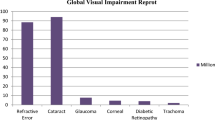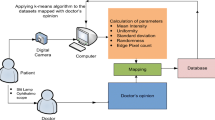Abstract
Cataract is considered as one of the foremost causes of blindness, especially among older people. In India, by the age 80, nearly half of older population either have cataract or they performed surgery for it. To avoid worse effects in eyesight like complete blindness or blurred vision, it is essential that cataract cases are detected in the initial stages for effective treatment. For detecting eye cataracts, the machines utilizing are exhibiting portability issues. Hence, this study is using digital image processing algorithms for the detection and classification of cataract on eye images along with its severity. Initially, the features such as color, shape and texture are extracted separately. Significantly, Novel Angular Binary Pattern- NABP is proposed for the texture feature extraction. The classification of images are performed in this study using the proposed Kernel Based Convolutional Neural Network after the feature extraction process. For all three feature types, the results are obtained separately. Performance of the proposed system is comparatively analyzed in terms of Accuracy, Sensitivity, Specificity, Precision, Recall and F – measure. In addition, comparative analysis is undertaken with respect to texture, colour and shape features. Classification results of the proposed system for varying epochs are also analyzed. Thus, all the analytical results confirmed the outstanding performance of the proposed system than conventional systems for cataract detection with 97.3% accuracy.











Similar content being viewed by others
Data availability
N/A
References
Agarwal S, Kumar M, Jangir SK, Sharma C (2021) Computer-Aided Cataract Detection Using MLP and SVM. Artif Intell Global Soc Impact Practice:103. https://doi.org/10.1201/9781003006602-10
Agarwal S, Kumar M, Jangir SK, Sharma C (2021) "Computer-Aided Cataract Detection Using MLP and SVM," in Artif Intell Global Soc, ed: Chapman and Hall/CRC, pp. 103–114
Ahmad HM, Hameed SR (2020) "Eye Diseases Classification Using Hierarchical MultiLabel Artificial Neural Network," in 2020 1st. Information Technology To Enhance e-learning and Other Application (IT-ELA, pp. 93–98. https://doi.org/10.1109/IT-ELA50150.2020.9253120
Ahmed HM, Hameed SR (2021) Eye Diseases Classification Using Back Propagation Artificial Neural Network. Eng Technol J 39:11–20. https://doi.org/10.30684/etj.v39i1B.1363
Amirtha J (2018) "Cataract Classification, Grading & Detection Methods–A Survey," Edit Special Issue J, p. 71
Cao L, Li H, Zhang Y, Zhang L, Xu L (2020) Hierarchical method for cataract grading based on retinal images using improved Haar wavelet. Infor Fusion 53:196–208. https://doi.org/10.1016/j.inffus.2019.06.022
Daruich A, Matet A, Munier FL (2018) Cataract development in children with coats disease: risk factors and outcome. J American Assoc Pedia Ophthalmology Strabismus 22:44–49. https://doi.org/10.1016/j.jaapos.2017.09.009
Gali HE, Sella R, Afshari NA (2019) Cataract grading systems: a review of past and present. Curr Opin Ophthalmol 30:13–18. https://doi.org/10.1097/ICU.0000000000000542
Goh JHL, Lim ZW, Fang X, Anees A, Nusinovici S, Rim TH, Cheng CY, Tham YC (2020) Artificial intelligence for cataract detection and management. The Asia-Pacific J Ophthalmology 9:88–95. https://doi.org/10.1097/01.APO.0000656988.16221.04
Gour N, Khanna P (2021) Multi-class multi-label ophthalmological disease detection using transfer learning based convolutional neural network. Biomedical Signal Processing and Control 66:102329, 1746-8094. https://doi.org/10.1016/j.bspc.2020.102329
Holennavar V, Kumar P (2017) Instant Detection of Cataracts. Int J Res Adv Dev (IJRAD) 1(4):77–81.
Imran A, Li J, Pei Y, Yang J-J, Wang Q (2019) Comparative analysis of vessel segmentation techniques in retinal images. IEEE Access 7:114862–114887. https://doi.org/10.1109/ACCESS.2019.2935912
Imran A, Li J, Pei Y, Akhtar F, Mahmood T, Zhang L (2020) Fundus image-based cataract classification using a hybrid convolutional and recurrent neural network. Vis Comput 37:1–11. https://doi.org/10.1109/IST.2014.6958452
Jiang J, Lei S, Zhu M, Li R, Yue J, Chen J, Li Z, Gong J, Lin D, Wu X, Lin Z, Lin H (2021) Improving the generalizability of infantile cataracts detection via deep learning-based Lens partition strategy and multicenter datasets. Front Med 8:470, 1–14. https://doi.org/10.3389/fmed.2021.664023
Kaur J, Sinha P, Shukla R, Tiwari V (2021) "Automatic Cataract Detection Using Haar Cascade Classifier," in Data Intell Cogn Inf, ed: Springer, pp. 543–556
Kim M, Eom Y, Song JS, Kim HM (2018) Effect of cataract grade according to wide-field fundus images on measurement of macular thickness in cataract patients. Korean J Ophthalmol 32:172–181. https://doi.org/10.3341/kjo.2017.0067
Kolhe S, Guru SK (2016) Remote automated cataract detection system based on fundus images. Int J Innov Res Sci Eng Technol 5:23
Kumar BR, Shimna M (2017) “Recent Approaches for Automatic Cataract Detection Analysis Using Image Processing,” J Netw Commun Emerg Technol (JNCET) vol. 7 https://www.jncet.org,
Lin H, Liu L, Wu X (2021) "Artificial Intelligence for Cataract Management," Artif Intell Ophthalmology, ed: Springer, pp. 203–206
Liu Y-C, Wilkins M, Kim T, Malyugin B, Mehta JS (2017) Cataracts. Lancet 390:600–612. https://doi.org/10.1016/s0140-6736(17)30544-5
Manchalwar M, Warhade K (2017) "Detection of cataract and conjunctivitis disease using histogram of oriented gradient," Int J Eng technol (IJET). https://doi.org/10.21817/ijet/2017/v9i3/1709030214
Ouabida E, Essadike A, Bouzid A (2018) Automated segmentation of ophthalmological images by an optical based approach for early detection of eye tumor growing. Physica Medica 48:37–46. https://doi.org/10.1016/j.ejmp.2018.03.014
Pahuja R, Sisodia U, Tiwari A, Sharma S, Nagrath P (2022) "A Dynamic Approach of Eye Disease Classification Using Deep Learning and Machine Learning Model," in Proceed Data Anal Manage, ed: Springer, pp. 719–736
Podkowinski D, Sharian Varnousfaderani E, Simader C, Bogunovic H, Philip A-M, Gerendas BS, Schmidt-Erfurth U, Waldstein SM (2017) Impact of B-scan averaging on Spectralis optical coherence tomography image quality before and after cataract surgery. J Ophthalmology 2017. https://doi.org/10.1155/2017/8148047
Pratap T, Kokil P (2021) Efficient network selection for computer-aided cataract diagnosis under noisy environment. Comput Methods Prog Biomed 200:105927. https://doi.org/10.1016/j.cmpb.2021.105927
Shaheen I, Tariq A (2019) "Survey Analysis of Automatic Detection and Grading of Cataract Using Different Imaging Modalities," in Applications of Intelligent Technologies in Healthcare, ed: Springer, pp. 35–45. https://doi.org/10.1007/978-3-319-96139-2_4
Shehzad M, Qadri S, Aslam T, Qadri SF, Razzaq A, Muhammad S et al (2020) Machine vision based identification of eye cataract stages using texture features. Life Sci J 17:44–50. https://doi.org/10.7537/marslsj170820.07
Shetty A, Bathija K, Priya R (2021) Cataract eye detection using machine learning models. Emerging Technologies in Data Mining and Information Security: Proceedings of IEMIS 2020(3):919–929.
Simamora W, Lubis R, Zamzami E (2020) A Classification: using Back Propagation Neural Network Algorithm to Identify Cataract Disease. J Phys Conf Ser:012037. https://doi.org/10.1088/1742-6596/1566/1/012037
Soni A, Rai A (2021) "Automatic Cataract Detection Using Sobel and Morphological Dilation Operation," in Proceedings of Research and Applications in Artificial Intelligence, ed: Springer, pp. 267–276
Sreejaya MK, Vijayan A, Krishnan A, Sreedharan D (2017) Various cataract detection methods-a survey. Int Res J Eng Technol (IRJET) 4:1517–1519.
Sreejaya MK, Vijayan A, Krishnan A, Sreedharan D (2017) Various cataract detection methods-a survey
Tawfik HR, Birry RA, Saad AA (2018) Early Recognition and Grading of Cataract Using a Combined Log Gabor/Discrete Wavelet Transform with ANN and SVM. Int J Computer Inf Eng 12:1038–1043. https://doi.org/10.5281/zenodo.2022731
Tripathi P, Akhter Y, Khurshid M, Lakra A, Keshari R, Vatsa M, Singh R (2022) MTCD: cataract detection via near infrared eye images. Comput Vis Image Underst 214:103303, 1–10. https://doi.org/10.1016/j.cviu.2021.103303
Weni I, Utomo PEP, Hutabarat BF, Alfalah M Detection of Cataract Based on Image Features Using Convolutional Neural Networks. IJCCS (Indonesian J Comput Cyber Sys) 15:75–86. https://doi.org/10.22146/ijccs.61882
Xiong L, Li H, Xu L (2017) An approach to evaluate blurriness in retinal images with vitreous opacity for cataract diagnosis. J Healthcare Eng 2017. https://doi.org/10.1155/2017/5645498
Xu X, Zhang L, Li J, Guan Y, Zhang L (2019) A hybrid global-local representation CNN model for automatic cataract grading. IEEE J Biomed Health Inf 24:556–567. https://doi.org/10.1109/JBHI.2019.2914690
Xu X, Li J, Guan Y, Zhao L, Zhao Q, Zhang L, Li L (2021) GLA-net: a global-local attention network for automatic cataract classification. J Biomed Inform 124:103939. https://doi.org/10.1016/j.jbi.2021.103939
Yang J-J, Li J, Shen R, Zeng Y, He J, Bi J, Li Y, Zhang Q, Peng L, Wang Q (2016) Exploiting ensemble learning for automatic cataract detection and grading. Comput Methods Prog Biomed 124:45–57. https://doi.org/10.1016/j.cmpb.2015.10.007
Zafar R, Sharif M, Yasmin M (2018) A survey on the prevalence of cataract and its accompanying risk factors. Curr Med Imaging. 14(2):251–262. https://doi.org/10.2174/1573405613666170331103423
Zhou Y, Li G, Li H (2019) Automatic cataract classification using deep neural network with discrete state transition. IEEE Trans Med Imaging 39:436–446. https://doi.org/10.1109/TMI.2019.2928229
Funding
This research work was not funded by any organization/institute/agency.
Author information
Authors and Affiliations
Contributions
I Am Dr. A. Sirajudeen Hereby State That The Manuscript Title Entitled “Detection of Cataract through feature extraction by the Novel Angular Binary Pattern (NABP) and classification by Kernel Based Convolutional Neural Networks” Submitted To The Multimedia tools and applications, I Confirm That This Work Is Original And Has Not Been Published Elsewhere, Nor Is It Currently Under Consideration For Publication Elsewhere. And I Am Professor In the Department of ECE, Aurora’s Scientific & Technological Institute, Aushapur, Ghatkesar, Telangana.
I’m the corresponding author of our paper, my contribution work on this paper is to Writing, developing, and reviewing the content of the manuscript. And my co-author Anuradha balasubramaniam, and Dr.S.Karthikeyan works were to cite the figure, table and references. Equally I have done 35% and my second author has done 35% of the work and my third author have done 30%. We are the entire contributors of our paper. And no other third party people are not involved in this paper.
Corresponding author
Ethics declarations
Ethics approval
No animals or human participants are involved in this research work.
Informed consent
I confirm that any participants (or their guardians if unable to give informed consent, or next of kin, if deceased) who may be identifiable through the manuscript (such as a case report), have been given an opportunity to review the final manuscript and have provided written consent to publish.
Conflict of interest
I confirm that this work is original and has either not been published elsewhere, or is currently under consideration for publication elsewhere. None of the authors have any competing interests in the manuscript.
Additional information
Publisher’s note
Springer Nature remains neutral with regard to jurisdictional claims in published maps and institutional affiliations.
Rights and permissions
About this article
Cite this article
Sirajudeen, A., Balasubramaniam, A. & Karthikeyan, S. Novel angular binary pattern (NABP) and kernel based convolutional neural networks classifier for cataract detection. Multimed Tools Appl 81, 38485–38512 (2022). https://doi.org/10.1007/s11042-022-13092-8
Received:
Revised:
Accepted:
Published:
Issue Date:
DOI: https://doi.org/10.1007/s11042-022-13092-8




